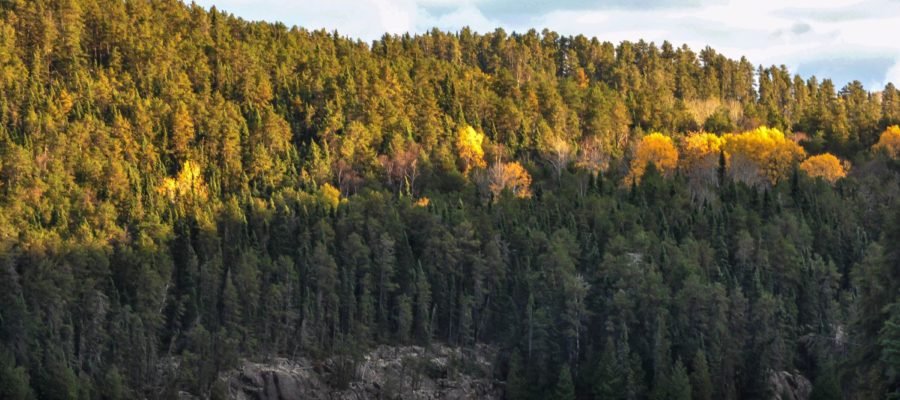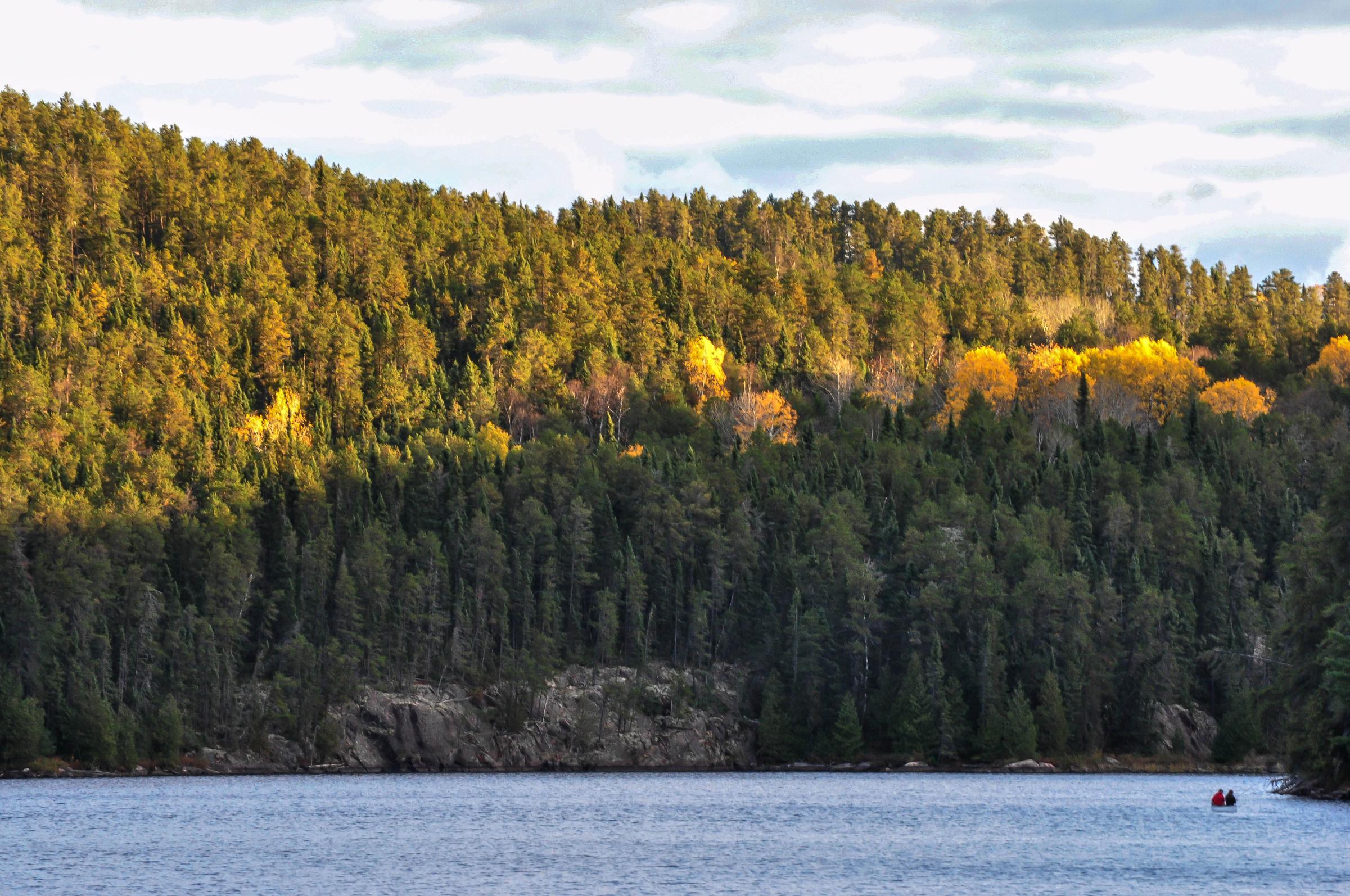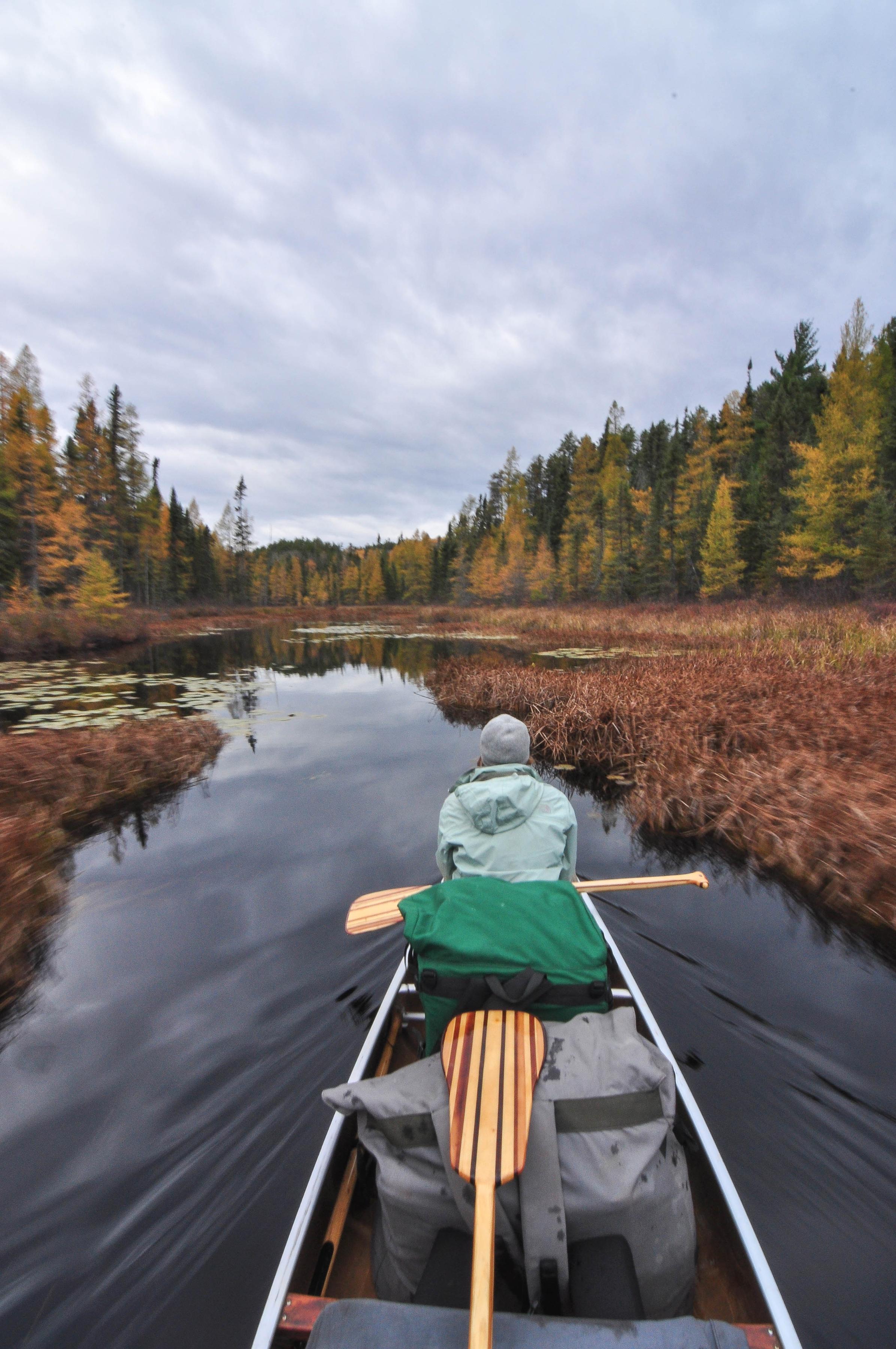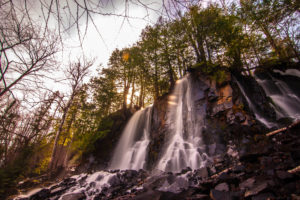OCT 6
Another steely cold day greets us as we emerge from our tents. At least it’s calm. By mid-morning we are cruising towards our first portage. After spending a day weather bound we are looking forward to covering some ground. We eye the 1200 meter portage between Trant and Kahshahpiwi, knowing not the toll it will exact on us. Packs are hefted and by 11am we are moving. After 300 meters the portage veers into a swampy section. Plenty of foot prints encourage us to press on. The trail grows even fainter as it climbs back onto solid rock, and then drops back onto a field of muck and tamarack. It now seems we are following a single set of boot prints. The muck field opens up into what looks like a drained beaver pond, holding 6 inches of black sludge. Loading a canoe on the edge of such a mess looks almost as impossible as paddling on it, so we stay on what footing we have. As we approach a wall of ostensibly impenetrable downed tamarack, the boot prints vanish, and our minds race. This cannot possibly be the portage trail. We drop packs and back track, in search of a better way. The entire swamp is surrounded by steep cliffs, leading us to believe we didn’t miss the real portage. We conclude that the quagmire must usually hold enough water to paddle. Obviously it doesn’t now, so we’ll make our own portage. After returning for boats we pull out our Sven saws and begin clearing a path through the tangled mess. Attempting to maneuver yourself and a saw through a thick stand of eyeball impaling Tamarack is dreadful. Waist high downed Spruce threatens to pierce a femoral artery, and the layer of fetid muck tries to steal our boots. Sweat pours from our brows, and obscenities pour from our gaping mouths. Again we have no alternative but to press on. At last we reach solid ground, a broken beaver dam, and the portage; somehow none of us have been perforated. Our new bush portage does the trick as we head back to gather packs and canoes. Thinking our troubles must be behind us we move quickly down the portage, reach Kahshahpiwi and realize they are not. Once more low water levels haunt us. The landing is a bone dry, the creek barely a trickle and choked with the devious work of beavers. Water is visible 100 meters up the shoreline, we head towards it. Soon we are bobbing atop an open expanse of bog. Each step is a gamble. As I hopscotch across floating islands of dirt and grass I hear the shrieks and curses of lost gambles behind me. Three hours after we started, at last we reach the shores of Kahshahpiwi. With the day half gone, we start paddling. A light Northwest wind does little to impede our progress up Kahshahpiwi and Keefer. After hauling into Sark Lake the shadows grow long and we decide it wise to stop. A nice island site is procured, and while splitting firewood the days clouds make their way East just in time for sunset. Tacos with fresh guacamole go a long way in boosting spirits after another long and arduous day. Clear skies give way to temperatures in low 20’s and we sleep hard.
OCT 7
It is gray and calm as we load canoes and anticipate advancing farther into the core of Quetico. The pleasurable days of sun and color are gone. Vibrant trees of yellow and red have been stripped of their pigment by the gales of yesterday’s storm. They now stand as ghosts of fall, portents of winter. Our progress is swift up Sark and Cairn Lakes. We slice through glass calm waters with considerable ease. At the north end of Cairn we veer west, and carry over into Heronshaw. Our eyes stare skyward as the blanket of dull breaks up, and the winds increase. During our short paddle to the portage into Metacryst Lake the winds pick up even further. On closer inspection the waters of Metacryst are quite unsettled. Belligerent little whitecaps are whipping up in a hurry, with noticeable ambitions for a bulkier existence. We make haste and struggle to get started into the headwind. Our arms are still recovering from battle with Hurlburt two days prior, so it is fortunate we only toil a mile. We portage into an unnamed lake and portage again into Baird Lake before lingering for lunch. Cheese and jerky help us in our continued struggle to the west. Everyone is frustrated with the incessant winds. Whichever direction we turn our canoes, the winds turn with us. After a week of travel I joke with confidence that we can navigate without maps, simply paddle into the wind and we’ll make it Atikokan eventually. The portage out of Baird into Cutty creek is slightly better than bushwhacking. Thick balsam stands reach out to seize every strap, buckle and fold on our packs. Piloting canoes through such a labyrinth of sharp twists proves maddening. As soon as we consider the possibility were on the wrong path, we discover the creek. It’s a perfect creek. This late in the year we are leery of creeks and their record of low water, but Cutty creek is plenty full. A dense thicket of still yellow Tamaracks crowd the creek, protecting us from bothersome winds, and provide an enchanted scene. As we creep along my mind wanders. I love mysterious dark forests, they conjure fantastical images. Somewhere in that shadowy abyss lies a tiny cottage, enveloped in mats of dangling mosses and moisture. A crooked chimney aims a wisp of curling smoke towards the tree tops. Behind a round golden window hangs a flickering lantern. Inside, the air is heavy with aroma. Warm vestiges of cedar and spruce dominate the senses, inducing heavy eyes, a want for the overstuffed easy chair next to the wood stove, and a steaming cup of tea. A cold slap of wind jars my mind back to reality. Our crew exits the protection of Cutty and plods once more into our foe. Eag Lake fortunately turns us to the north, and easier paddling. A lack of campsites and rugged portages suggest this route is rarely travelled. We have intelligence that advocates for setting up on a nice site on Camel Lake. It puts our minds at ease knowing a site exists, since we have been deceived in the most infuriating way two days prior. The remaining portion of Cutty Creek is again captivating. Around every bend we flush dozens of waterfowl. Mergansers, mallards, and the occasional Canadian goose flee as we approach. The advice we received on the Camel campsite was correct, as we find it more than adequate. It is a nice flat point facing west nestled amongst old growth white pines, some of the largest we have seen yet. Plenty of cedar is secured and we dine on fresh pesto and biscuits. The weather robot predicts rain, so we pitch tents. As the silence of the night fills me with calm I return to my cabin in the hollow, and fall asleep next to the fire.





Leave a Reply
Your email is safe with us.
You must be logged in to post a comment.